Bolton Consultancy Ltd
News Archive
December 2020 - Revision to Standard for Flammability of Toys Published.
EN 71-2:2020 Safety of Toys Flammability, was published in December, replacing BS EN 71-2:2011+A1:2014.
This standard is the second in a 13-part series on toy safety, dealing with toy flammability and is used to help manufacturers improve toy safety and comply with the requirements of the EU’s Toy Safety Directive. This was specially produced to increase levels of child safety when wearing “fancy dress” or “disguise costumes”, which are classed as toys.
The key changes include:
- Increases the number and type of test specimens taken from toy disguise costumes,
- Adds new definitions, including for cleansing, flowing elements, highly flammable solids, toy disguise costumes, toys intended to be entered by a child and washing,
- Adds new requirements, e.g. for disguise costumes to be tested before and after washing, and for loose stuffing,
- Increases the testing of smaller specimens by allowing combined or half-size specimens,
- Adds clarifications on the measurement of unhindered dimensions, and of test categories applicable to toys worn on the head and to toy disguise costumes,
- Adds new advice on assessing whether toys are to be entered,
- Adds an annex on suggestions to manufacturers on how to reduce the rate of flame spread,
- Adds an annex that clarifies how to obtain test specimens from disguise costumes,
- Illustrated clarification of toy head dresses, masks and hats with applicable test clauses.
October 2019 - CEN TC248 WG20 Meeting at the SIS in Stockholm
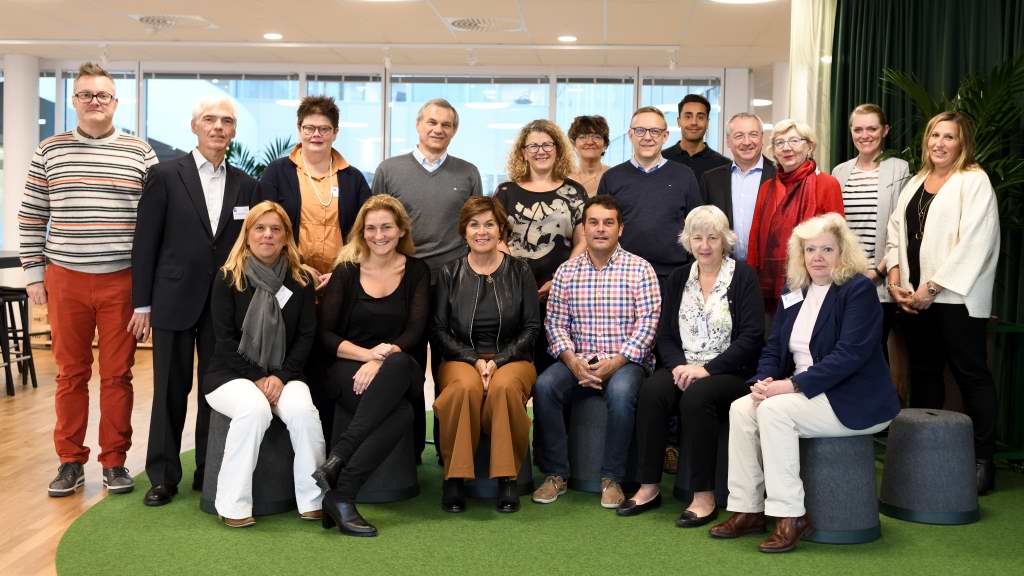
The annual meeting of CEN TC 248, European standards technical committee for textile and textile products was hosted by the Swedish Institute for Standards in October 2019.
A two day WG 20 Safety of children’s clothing, convened by Sue, was also held and was attended by 16 experts (pictured). WG20 continues to progress the development of FprCEN/TS 17394-3, Safety of Children's Clothing - Security of Attachment of metal mechanically applied press fasteners - Test method, FprCEN/TS 17394-4, Safety of Children's clothing – Security of attachment of components except buttons and metal mechanically applied fasteners – Test method, and FprCEN/TS 17394-1, Textiles and textile products – Safety of children's clothing – Security of attachment of attached components to Infants' clothing – Specification.
July 2019 - Two new European standards published.
CEN/TR 17376:2019 Textiles - Safety of children's clothing - Guidance on the use of EN 14682:2014 Cords and drawstrings on children's clothing – Specifications
Written in the form of questions and answers with photos and illustrations, this standard is designed to support EN 14682:2014; it does not replace EN 14682:2014 which is harmonised under the GPSD. The content responds to common questions referred to the committee members for clarification and mainly reflects the rapid changes in fashion, and the cascade of adult styling to children's clothing.
A similar document, CEN /TR 16446:2012, was issued to support the earlier version of EN 14682:2007 which was withdrawn on the publication of EN 14682:2014.
Continuous changes in fashion, and analysis of current fashion for children requires the CEN Technical Committee to ensure these standards remain current and a further revision of EN 14682:2014 is now in progress.
EN 17130:2019 Textiles and textile products – Determination of dimethylfumarate (DMFu), method using gas chromatography.
The standard describes a test method for determining the amounts of dimethyl fumarate (DMFu) in textile materials and textile articles (including desiccant sachets). It cannot be used for metal parts or components.
DMFu is restricted according to REACH regulations (see REACH Annex XVII Entry 61).
July 2019 - New EN Test Method for Security of attachment of buttons
The new draft Standard has been issued by CEN for public comment:
prEN 17394-2 Textiles and textile products. Part 2: Safety of children's clothing - Security of attachment of buttons - Test method,
The document is available for comment on the web sites of member states' Standards organisations across the EU. BSI in the UK has BS EN 17394-2 at https://standardsdevelopment.bsigroup.com/categories/61 and comments can be submitted by following the links on that page. Please submit your comments by 26th August 2019.
The new standard specifies a test method for the security of attachment of buttons; assessments of other garment components are considered in:
FprCEN/TS 17394-3, Safety of Children's Clothing - Security of Attachment of metal mechanically applied press fasteners - Test method,
and
FprCEN/TS 17394-4, Safety of Children's clothing – Security of attachment of components except buttons and metal mechanically applied fasteners – Test method.
Performance recommendations are provided in
FprCEN/TS 17394-1, Textiles and textile products – Safety of children's clothing – Security of attachment of attached components to Infants' clothing – Specification.
These other 3 documents are Technical Specifications as the CEN working group was unhappy with the reproducibility of the test between labs for Part 3 and lack of familiarity with the wash test in Part 4. Work is in hand to progress these TS documents to full EN standards as quickly as possible; this will include further inter-laboratory trails to demonstrate reproducibility.
CEN/TS documents are not issued for public comment: they are considered by the national committee, in the UK, BSI TCI 66/-/1. If the committee considers them acceptable, they are published. Since all 4 documents are based on TR 16792, which in turn is an updated version of BS 7907, publication in UK is highly likely.
May 2019 - SDC Elects President 2019-2020

At their AGM held on Friday 10th May at the historic Merchant Adventurers' Hall in York, the Society of Dyers and Colourists elected Sue Bolton to be SDC President 2019 - 2020. Sue will represent the Society at a wide range of events over the coming year, including ITMA in Barcelona 20th to 26th June 2019.
After the AGM, the SDC held their annual Day of Celebration with an awards ceremony recognising individuals for their contribution to the profession, the industry and to the Society. In the evening after the SDC annual dinner the finalists in the UK Heats of the SDC' International Colour Design Competition were recognised and the winner Sarah Gotheridge from Nottingham College announced.

Maintaining a long tradition, Kerry M. King, President of the AATCC, presented a commemorative plaque recognising the President of the SDC as an Honorary Member in the American Association of Textile Chemists and Colorists May 2019 - April 2020.
Sue commented: "my Presidential mission is to promote the benefits of SDC membership, education and qualifications, particularly Chartered Colourist. This will promulgate better use of best available technology by the coloration industry, leading to reduced environmental impact".
November 2018 - The 12th China Forum on Textile and Apparel Standard and Quality Management
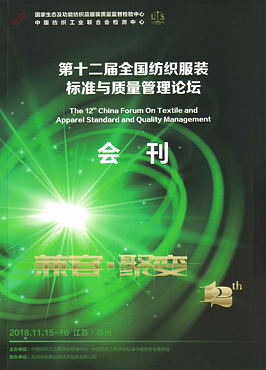
Sue was an invited speaker at the 12th CNTAC Forum on safety and quality management in Suzhou, China held 15th & 16th November 2018.
CNTAC, the China National Textile and Apparel Council, is the national Federation of textile-related industries in China. The conference drew more than 300 attendees from across China. The event opened with awards for quality improvement being made to around 50 Chinese textile companies.
The conference continued with presentations on a range of topics, including a review of compliance with national mandatory standards for textiles with presentations by CNTAC and local authorities' representatives. Sue's presentation explained the background to 'EN 14682:2014 Safety of Children's Clothing - Cords and Drawstrings on Children's Clothing - Specifications' and "CEN/TR 16792:2014 Safety of children’s clothing – recommendations for the design and manufacture of children’s clothing – mechanical safety", the requirements of these standards and how they fit with EU legislation, and compared these requirements to "GB 31701-2015 Safety Technical Code for Infants and Children Textile Products" and "T/CNTAC 1-2018 Guidance on Implementation of GB 31701, the safety technical code for infants and children textile products".
The day of formal presentations was followed by a less formal discussion on testing and interpretation of results, and concluded with a visit to Aimer's factory near Suzhou. Aimer is one of the leading lingerie brands in China www.aimeronline.com.
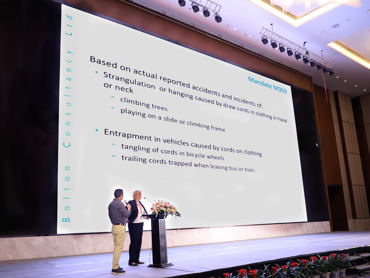
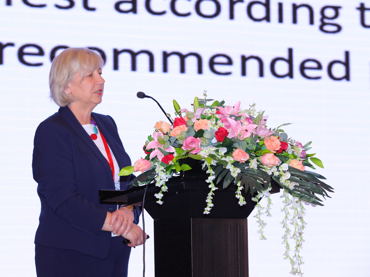
August 2018 - Three New European Standards Concerning Safe Bedding For Infants Published
New European Standards for children's sleep bags, cot bumpers and duvets for children, have been published in August 2018 and will be issued in the UK as British standards: BS EN 16781:2018, BS EN 16780:2018, and BS EN 16779-1:2018.
The three standards were written by a joint working group (CEN/TC248/WG34), convened under the CEN committees TC248 Textiles and CEN TC252 Child Care Articles, in response to European Commission Mandate No M/497, "Standardisation mandate to CEN, CENELEC and ETSI on the safety of child-care articles; Cluster 2 - risks in the sleeping environment; Mattresses for cots, cot bumpers, suspended beds for children, duvets for children, sleep bags for children". The two remaining products (italicised above) are being covered by other work groups.
The standards have been developed to be harmonised under the General Product Safety Directive (enacted in UK as General Product Safety Regulation) so products in compliance with these standards will be presumed to be safe.
These safety specifications are new for most countries, and the provision of labelling, warnings and instructions for use in the local language forms part of the safety of the product. This aspect is expected to be strongly enforced by Market Surveillance Officers (Trading standards in the UK).
All three standards have an 18 month transition period commencing 1 August 2018 to allow existing stock to be sold through.
EN16781:2018 Textile child care articles. Safety requirements and test methods for children's sleep bags.
It is expected that "BS8510:2009 Child use and care articles ‒ Safety of children's sleep bags ‒ Safety requirements and test methods" will be withdrawn. Sleep bags made in compliance with EN16781 will be accepted as safe products throughout the UK and Europe.
The standard provides design limitations to make the sleep bag inherently safe for example:
- limiting the neck opening size to ensure baby cannot slide inside,
- prohibiting cords and drawstrings to eliminate strangulation and entrapment hazards,
- setting thermal (tog) performance to avoid baby overheating.
Other requirements include;
- the minimum removal force for press fasteners and buttons,
- a stitch length specification to ensure filling cannot escape and fingers or toes cannot be tangled in seam openings,
- prescriptive labelling, warnings and instructions for use to be provided.
EN 16780:2018 Textile child care articles. Safety requirements and test methods for children's cot bumpers
EN 16780:2018. Textile child care articles. Safety requirements and test methods for children's cot bumpers This will replace certain parts of "BS1877-10:2011+A1:2012 Domestic bedding. Specification for mattresses and bumpers for children's cots, perambulators and similar domestic articles", relating to cot bumpers.
Like EN16781, this has been drafted in response to an EU Commission Mandate, and when harmonised will have similar status.
Many requirements are based on BS1877-10, with enhancements similar to those used for infants clothing, so they are known to be achievable in production. The emphasis has been on inherent safe design so for example;
- features like pockets are not permitted,
- certain components such as suction caps and magnets are prohibited,
- length of cords to attach to cot are consistent with BS1877-10,
- certain attached decorative components are prohibited.
Specific marking, warnings and instructions for use have been provided in the standard.
IMPORTANT: Cot bumper have been a major discussion topic by professional infant health providers world-wide, and in certain US states have been prohibited.
EN 16779-1:2018. Textile child care articles. Safety requirements and test methods for children's cot duvets. Part 1. Duvet (excluding duvet covers)
This standard considers all duvets, and quilts or comforters with a non-removable cover. The removable cot duvet covers will be specified in Part 2 of the standard which is under development.
There is no existing standard for cot duvet; however, for several years UK health professionals have recommended that cot duvets are not suitable for infants under 12 months.
EN16799-1 is applicable to duvets up to 120 cm x 140cm. Larger duvets are not in scope; however, many aspects of the standard represent good practice for product construction and manufacture.
EN 16799-1 provides safety requirements for the design, materials and construction for the cot duvet to deliver inherent safety by design and manufacture. These include
- Maximum thermal (tog) performance to avoid over heating of the baby, a known contributory factor in Sudden Infant death, SIDS
- Requirements for sewing construction in terms of seam bight, sewing stich, stich length and thread, to avoid weak seams and release of filling material
- Cleanliness of fillings
- Washable duvet
The standard also provides requirements for Specific marking (labelling) to provide as well as specific warnings and instructions for use.
IMPORTANT France has national legislation concerning flammability performance of duvets which is applicable in that country.
Copies of these standards can be obtained from BSI or your local national standards organisation. Please contact info@boltonconsultancy.co.uk for further information.
May 2018 - Labelling Seminar in Belgium
Sue delivered a seminar covering the Essentials of Labelling for clothing, home textiles and footwear to 29 IVOC/CREAMODA members on 17th May. The seminar included labelling compliance with the GPSD, Textile labelling regulation, Biocidal products, footwear, labelling care symbols, UK and Irish nightwear flammability legislation; together with discussion of best practice for products for the whole european market.
.jpg)
.jpg)
November 2017 - CEN TC248 WG20 Meeting at the SDC in Bradford
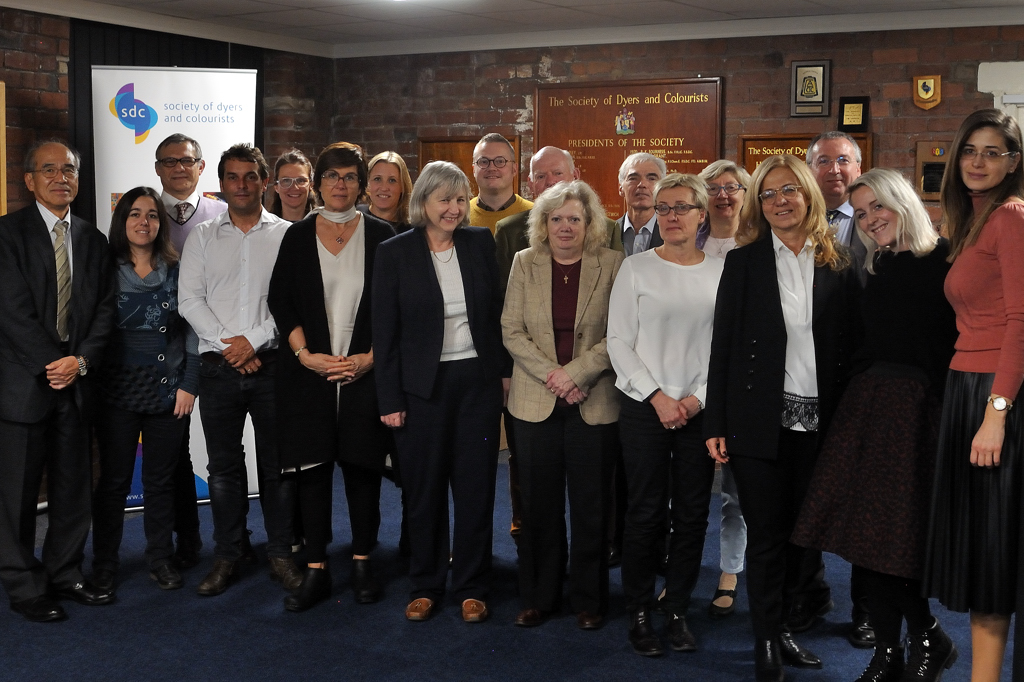
The annual meeting of CEN TC 248, European standards technical committee for textile and textile products was held at SDC’s offices in Bradford West Yorkshire in November; with support from SDC Enterprises, BTTG, NCWA, UKFT, SGS, Intertek, Holdstock Technical Services, TSA and organised by Bolton Consultancy Limited.
Four working groups met during the week, including WG 20 Safety of children’s clothing, which is convened by Sue and was attended by 16 experts from Belgium, France, Italy, Netherlands, Spain, Sweden, Turkey and UK (pictured).
October 2017 - ISO TC38 Meeting New Orleans
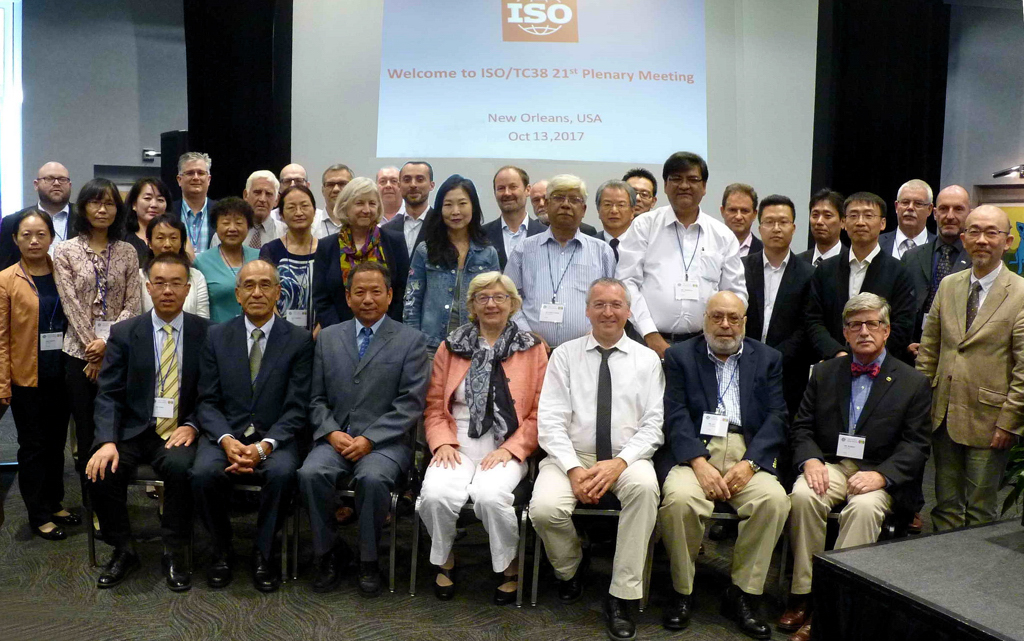
The ASTM and AATCC hosted ISO TC 38 in the USA in October 2017 which met in New Orleans.
Sue chaired ISO TC 38 Textiles SC1 tests for colourants and coloured textiles (colour fastness) which was attended by 52 experts from 9 countries. She also attended ISO TC 38 plenary and ISO TC 38 SC2 care labelling, cleansing and water resistance tests as UK expert.
September 2017 - International China Legislation Conference 2017 Barcelona
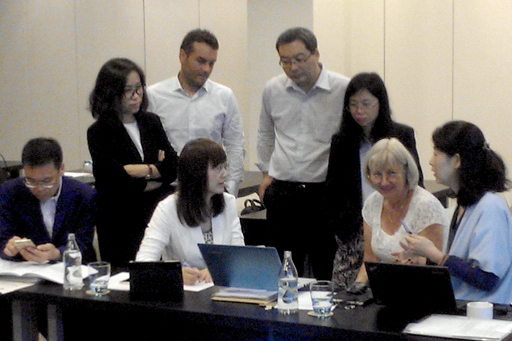
An international conference for delegates invited from across the industry in the EU was held in Barcelona, Spain, to share and promote understanding of Legislation and Standards for the safety of children’s clothing and related products in China and in the EU. The conference assembled a panel of representatives from the standardisation bodies of both China and the EU including Mr Sun Ximin from CNTAC and Mrs Ingrid Soetaert from CEN together with the experts responsible for drafting the respective standards:
- Mrs Xu Lu from SAC explained GB 31701-2015 Safety technical code for infant's and children's textile products and T/CNTAC/Z 1-2017 Guidance on Implementation of GB 31701 Safety technical code for infant's and children's textile products.
- Sue Bolton explained the EU legislation and standards in this area and how they work together.
Delegates were invited to address detailed questions and requests for clarification to the panel which considered the questions in detail and reported back the following day.
December 2016 - Printwear & Promotion Special Report
Sue Bolton expains the implications of Brexit on textile product quality and safety legislation and standards in a special report published in Printwear and Promotion December 2016 - "Brexit - Life after [Article] 50".
Printwear and Promotion, the leading journal for the decorated garment industry, is available to registered readers as a printed or digital publication. The report can be read on the Printwear and Promotion website http://www.printwearandpromotion.co.uk/brexit-life-article-50/ .
September 2016 - Consultation on updating the Furniture & Furnishings Regulations
The UK Department for Business, Energy and Industrial Strategy (BEIS) have issued the following request as part of their consultation on updating the Furniture & Furnishings Regulations:
We would like your views on changes that we propose to make to the current regulations. We plan to remove the 1988 Furniture and Furnishings (Fire) (Safety) Regulations and replace them with an updated version - the 2016 Furniture and Furnishings (Fire Safety) Regulations. We would welcome your comments on the proposals and the draft of the new regulations.
The draft regulations are included in the consultation document which may be viewed on the GOV.UK website at: https://www.gov.uk/government/consultations/furniture-and-furnishing-fire-safety-regulations-proposed-changes-2016.
You can respond to the survey online at: https://beisgovuk.citizenspace.com/er/proposal-to-revise-1988-furniture-and-furnishings
If you wish to make comments the closing date of this consultation is 11 November 2016.
July 2016 - Standards Update
A number of new and revised Standards have been issued relating to Textiles:
NEW BS EN 16812:2016 Textiles and textile products — Electrically conductive textiles — Determination of the linear electrical resistance of conductive tracks.
This European Standard describes a test method for the determination of the linear electric resistance of conductive tracks for textile structures or intended for application in/to textiles, e.g. yarns, printed or coated tracks, ropes, ribbons and webbing. The Standard is designed for materials showing Ohmic behaviour and for conductive tracks where electrical contact between the measurement electrodes and the conductive track is possible.
NEW PD/CEN/ISO TR 11827:2016 Textiles — Composition testing — Identification of fibres
(ISO/TR 11827:2012). The TR explains how to systematically test an unknown textile material to identify qualitatively the different fibres present. It is intended this TR may be used prior to testing according to BS EN ISO 1822 series for quantitative determination of each fibre present. This TR is identical to he ISO TR published in 2012.
BS EN ISO 105 D02:2016 Textiles — Tests for Colour fastness to rubbing: Organic solvents
Editorial revision only.
BS EN ISO 105 G01:2016 Textiles — Tests for colour fastness Nitrogen oxides
Editorial revision only.
BS EN ISO 105 G04:2016 Textiles — Tests for colour fastness to nitrogen oxides in the atmosphere at high humidities.
Revised and updated: The main technical changes are the following:
- delete the test-control fabric dyed with Disperse Blue 3;
- add the test-control fabric dyed with Disperse Violet 1 and the test-control fabric dyed with Disperse Blue 56.
BS EN ISO 105 X 12:2016 Textiles — Tests for Colour fastness to rubbing.
Editorial revision only.
BS EN ISO 105 X16:2016 Textiles — Tests for colour fastness to rubbing — Small areas
Editorial revision only
April 2016 - Standards Development - Public Comment
Three new draft British / European standards for infant sleep bags, cot duvet and cot bumpers have been issued for a second public comment. The full titles are:
Pr BS EN 16779 Textile child care articles - Safety requirements and test methods for children's cot duvets Part 1: Duvet (excluding duvet covers).
Pr BS EN 16780 Textile child care articles - Safety requirements and test methods for children's cot bumpers.
Pr BS EN 16781 Textile child care articles - Safety requirements and test methods for children's sleep bags.
Draft Standards for Public Comment
Part of the process of developing European and International Standards includes a period of consultation when the draft Standard is made available for public comment. For European and international standards, all comments are distilled by the national committee to a national point of view and submitted to the relevant CEN or ISO group for review. In all cases comments must either be accepted or rejected with a reason, and documented by the committee.
You can contact your National Standards organisation for further information but in the UK consultation is organised by the BSI on their website. Many of the standards are test methods; but increasingly product specifications, or the methods used to support a specification are being developed and Committees need to know that the standards are clear to all users, and relevant to today’s products.
In the UK, to review draft standards and post your comments to BSI you need to register at http://drafts.bsigroup.com - you can then search for or select standards of interest and begin. When you read the standard, a box will open for each clause, and any text inserted will automatically be referenced and tabulated for the committee to review. You will not be able to download the standard, as it is still under development. Every comment posted is reviewed by the BSI committee.
July 2015 - EN14682:2014 Harmonised
The reference to EN 14682:2014 'Safety of Children's Clothing - Cords and Drawstrings on Children's Clothing - Specifications' was published in the Official Journal of the European Union on 4th August 2015. Supporting it's decision the Commission includes the following paragraph in its announcement:
In response to the Commission's mandate, CEN adopted standard EN 14682:2014 ‘Safety of children's clothing — Cords and drawstrings on children's clothing — Specifications’ which supersedes standard EN 14682:2007. Standard EN 14682:2014 fulfils mandate M/309 and complies with the general safety requirement set out in Directive 2001/95/EC. Its reference should therefore be published in the Official Journal of the European Union replacing the reference of standard EN 14682:2007.
July 2015 - Standards Development - Current Work
European Standards development working groups are currently drafting the following standards concerning Children's products:
Pr EN 16732 Slide (zip) fasteners – Specification
The content of this standard is very similar to BS 3084, with an additional torque test on the zip puller.
It is intended that this will replace BS 3084, and other national European standards which will be withdrawn. It will be specified in standards for products which use zips.
Replaces: BS 3084Anticipated:End 2015
Pr EN 16779-1 Textile child care articles – Safety requirements and test methods for children’s cot duvets Part 1: Duvet (excluding duvet covers)
This standard is being developed in response to a EU commission mandate, and when published, will be harmonised under the General Product Safety Directive.
Across Europe a high number of fatalities have occurred in cots which have been attributed to the use of duvets. The standard will define product manufacturing and performance requirements, with safety warnings, to provide safer products for the consumer. It will be limited to duvets suitable for cot use only to distinguish from single bed duvets.
UK recommendations supported by the NHS and Lullaby Trust (formerly SIDS Foundation), are that duvets are not suitable for infants under 12 months of age, as they can suffocate or over heat.
It is expected that the draft text will be issued for a second public Enquiry (consultation) later this year.
Replaces: New Standard Anticipated:2016
Pr EN 16779-2 Textile child care articles - Safety requirements and test methods for children's cot duvet covers Part 2: Duvet Covers (excluding duvet )
New standard to complement part 1. This deals with safety aspects of cot duvet covers only. This is in VERY early stages of development.
Replaces: New Standard Anticipated:N/A
Pr EN 16780 Textile child care articles - Safety requirements and test methods for children's cot bumpers
This standard is being developed in response to a EU commission mandate, and when published, will be harmonised under the General Product Safety Directive.
Across Europe a high number of fatalities and accidents have occurred in cots or by children falling out of cots which have been attributed to the use of cot bumpers. Cot bumpers across Europe are very different is design, materials and use compared to those typically sold in UK. Most incidents appear to be related to the cot bumper being used as a ladder to climb out of the cot, hence the UK recommendation to remove from the cot when the infant can sit up unaided.
The standard will define product design , manufacturing and performance requirements , with safety warnings to provide safer products for the consumer.
The requirements of BS 1877-10 have been used as a basis for this standard.
It is expected that the draft text is to be issued for a second public Enquiry (consultation) later this year.
Replaces: BS 1877-10 Anticipated:N/A
Pr EN 16781 Textile child care articles - Safety requirements and test methods for children's sleep bags
This standard is being developed in response to a EU commission mandate, and when published, will be harmonised under the General Product Safety Directive.
Across Europe a high number of fatalities have occurred in cots which have been attributed to the use of sleep bags of various designs, which would not comply with BS 8510. The standard will define product design, manufacturing and performance requirements, with safety warnings to provide safer products for the consumer.
BS 8510 requirements have been used as the basis of many of the proposed requirements.
The draft text is to be issued for a second public Enquiry (consultation) later this year.
Replaces: BS 8510 Anticipated:2016
December 2014 - NEW CEN Technical Report - CEN/TR 16792:2014
CEN/TR 16792:2014 Safety of children’s clothing – recommendations for the design and manufacture of children’s clothing – mechanical safety was published by CEN on 17th December 2014.
As a 'Technical report', no member state is obliged to publish, however it is expected most EU countries will adopt this TR. In the UK it is expected to be available from BSI in the New Year (British Standards Institution).
TR 16792 is based on BS 7907, updated to reflect current knowledge and best industry practice. The scope of the TR is very similar to BS 7907 and includes recommendations on the selection of components and fabrics as well as recommendations on performance for children's clothing.
For those already using BS 7907; security of attachment requirements have been updated. The key changes are:
- Textile components are no longer subjected to pull [tension] tests, in their place a durability wash is recommended,
- Glued and fused components such as diamantes, which are non-grippable, are also no longer subject to pull tests, and a durability wash is recommended,
- A new test method and performance recommendation has been added for the tensile strength of buttons. As the button itself can be highly variable in strength; this new recommended performance requirement will help in the selection of appropriate buttons.
Bolton Consultancy Ltd has training courses and refresher training which include the new requirements. Please contact info@boltonconsultancy.co.uk for further information.
17 December 2014 - Revised Standard Announced - EN 14682:2014
CEN has announced publication of an updated edition of EN 14682 'Safety of Children's Clothing - Cords and Drawstrings on Children's Clothing - Specifications'. EU Member states have until the end of June 2015 to adopt the new edition which will now be put forward to the GPSD committee to consider for Harmonisation.
The key changes are:
- The definitions of articles in scope and out of scope have been improved; and the rationale included in an annex,
- Throughout the standard, reference is now made to parts of the body and not parts of a garment,
- Requirements for hanger loops have been added,
- Decorative cords are now accepted for younger children; but with restrictions to consider hazards of strangulation. This is consistent with the existing treatment of permitted stitched on embellishment such as bows,
- For shoulder straps and halter neck, the use of ring and slider mechanisms has been revised to recognise that although the loop created is frequently larger than 7.5cm this does not create an entrapment hazard,
- Clarification that garments which are worn from the waist down, may have cords at the waist. If configured appropriately these are low risk and some requirements have been relaxed accordingly. For other flowing garments including unfastened coats, requirements have been enhanced.
Copies of the new edition are expected to be available from Member states standardisation bodies (BSI in the UK) shortly.
Bolton Consultancy Ltd has training courses and refresher training which include the new requirements. Please contact info@boltonconsultancy.co.uk for further information.
September 2014 - New BS EN Standards for nursery textile products
Three new draft BS EN standards for nursery textile products are available for public comments until 14th December 2014. All are being developed under a mandate from the EU Commission. Once published in 2015, it is intended that these will be harmonised under the General product safety Directive. Products meeting these requirements will be presumed to be safe.
All three standards deal with nursery products used in the home. The requirements do not relate to articles intended for outdoor use.
- Pr BS EN 16781 Textile child care articles - Safety requirements and test methods for children's sleep bags. This new EU standard takes as its basis and enhances many aspects of the safety of sleep bags covered in the UK in "BS 8510:2009 Child use and care articles. Safety of children's sleep bags. Safety requirements and test methods".
- Pr BS EN 16780 Textile child care articles - Safety requirements and test methods for children's cot bumpers. Currently in the UK cot bumpers are considered in "BS 1877-10 Domestic bedding. Specification for mattresses and bumpers for children's cots, perambulators and similar domestic articles". All of these requirements have been included in the EN standard, together with new requirements. On publication of the new EN standard, BS 1877-10 will be revised and conflicting causes removed.
- Pr BS EN 16779 Textile child care articles - Safety requirements and test methods for children's cot duvets Part 1: Duvet (excluding duvet covers). This standard will cover cot duvets and cot quilts. A separate standard in part 2 will consider removable duvet covers.
When the standards working group were developing these documents, it became clear that across EU countries the design and functions of these articles vary enormously and a wide range of materials have been in common use. The standards have had to be written to accommodate this variability and to focus on the safety of the infant.
SDC Children’s Wear Seminar - November 2013
The Society of Dyers and Colourists and De Montforte University , Leicester are presenting a Children’s Wear Seminar on Wednesday 6th November at De Montforte University , Leicester.
The seminar will be chaired by Dr Julie King, Head of Fashion and Textiles at De Montfort University. Speakers include:
- Sue Bolton will give an overview of the General Product Safety Directive relating to clothing, and how this legislation relates to standards,
- Claire Lerpiniere from De Montfort University will present a children’s wear project with George,
- Simon Allitt from ULVS (UK) Ltd will cover QA touchpoints in the supply chain of childrens wear; the concept from design to shopfloor – auditing factories for social and technical capabilities, testing the products at the right time and for the right tests and finally inspection of the goods and monitoring their performance in the marketplace with due diligence testing.
For further information and to book your place visit: www.sdc.org.uk/event/childrens-wear-seminar .
April 2013 - Proposal to Replace the General Product Safety Directive
The European Commission published proposals in early 2013, to replace the General Product Safety Directive with a new regulation; the General Product Safety Regulation (GPSR). The current directive had to be implemented in each member state as local legislation - hence the UK Government for example enacted the General Product Safety Regulations 2005. The proposed EU Regulation, when enacted, will apply in all member states directly; so removing the possibility of different interpretations in different states. In addition to replacing the GPSD the Commission are proposing a new regulation, the Market Surveillance of Product Regulation (MSPR) which will replace market surveillance provisions contained within the GPSD (and a range of other instruments) with a unified approach to market surveillance across the EU.
We explain the main elements of the new regulation here Proposed New GPSR .
January 2013 - Guidance on the use of EN 14682:2007 published
Full title: PD CEN/TR 16446:2012 Textiles — Safety of children’s clothing — Guidance on the use of EN 14682:2007 Cords and drawstrings on children’s clothing — Specifications
PD CEN/TR 16446:2012 is published on 31st January 2013. Formally a Published Document not a standard, this document explains some technical aspects of garment design and manufacture and has been developed in recognition of rapidly changing garment styles in the children's clothing sector. At the time of writing a revision of EN14682:2007 is in progress and is currently available for public comment until 31st January 2013. When the revision of EN14682 is published the Guidance document may be withdrawn.
October 2012 - Children’s Clothing (Hood Cords) Regulations 1976 removed.
Following consultation ending 23rd May 2012 the UK Children’s Clothing (Hood Cords) Regulations 1976 were removed from the statute book on 1 October 2012.
Requirements relating to hood-cord safety of Children's clothing remain in place under the General Product Safety Regulations; compliance with the Harmonised European Standard BS EN 14682:2007 providing presumption of conformity to the Regulations.
April 2012 - New Standard for Textile Care Symbols published
Full title: BS EN ISO 3758:2012 Textiles - Care labelling code using symbols (ISO 3758:2012)
ISO 3758:2012 is published April 2012 and supersedes BS EN ISO 3758:2005, which is withdrawn. This, the third edition of the standard, makes minor changes to some definitions and modifies the symbols for bleaching. New symbols have been added for natural drying - line drying and flat drying - together with a symbol for "do not professional wet clean" which refers to the low water wet cleaning process. More on Care Labelling and Symbols
March 2012 - New Standard Test Methods for detection of certain azo colorants published.
Full Title: BS EN 14362-1:2012 Textiles. Methods for determination of certain aromatic amines derived from azo colorants. Detection of the use of certain azo colorants accessible with and without extracting the fibres.
EN 14362-1:2012 is published 31st March 2012, and replaces EN 14362-1 and EN 14362-2 which are now combined in one document. This new edition has a number of clarifications regarding samples and which test to apply. Key points include the following:
- white is not a colour and does not require testing,
- how to deal with multi-coloured samples,
- how to deal with multi-component garments,
- a statement that up to 3 colours may be tested together,
- textiles which cannot be dyed with disperse dyes will only require one test,
- textiles which can only be dyed with disperse dyes - eg 100% polyester - will only require one test,
- only those textiles dyed with both disperse and non-disperse dyes require 2 tests - eg polyester/cotton fabrics.
The changes will considerably reduce overall costs of testing, and ensure due diligence spot checks can be more cost effective.
March 2012 - Children’s Clothing (Hood Cords) Regulations 1976 to be removed.
On 23rd March 2012 the British Government launched a consultation on proposals to remove regulations in retail and manufacturing sectors that their Red Tape Challenge has identified as no longer required.
Included in the list of twelve regulations, the Children’s Clothing (Hood Cords) Regulations 1976 were introduced to remove outer clothing such as raincoats from the market as their cords posed a strangulation risk to small children. However, the newer updated European Standard is now in place BS EN 14682, which covers cord and drawstring safety in all children’s garments and not just hoods on outer clothing.
The consultation is seeking views from businesses, the public and voluntary and community organisations on how these changes will impact them. It runs for eight weeks, closing on Wednesday 23 May.
Where regulations are to be removed, this will have effect from 1 October 2012.
You can see the consultation at www.bis.gov.uk/consultations
January 2012 - Sue Bolton appointed chair of ISO TC 38 SC1
Sue Bolton has been appointed chair of ISO TC 38 SC1, for a term running from January 2012 until the end of 2014.
ISO TC 38 SC1 is the International Standards Organisation’s sub-committee responsible for standard tests for fastness of coloured textiles and colorants and falls under ISO technical committee TC 38 - standards (methods of test and performance requirements) for textiles and textile products. Its scope includes all test methods for; assessing the colour fastness of textiles, colour measurement, and the colorants themselves.
Comprised of experts from 24 countries as active participants, together with experts from a further 17 countries holding observer status, the sub-committee is responsible for 113 published standards.
Current work items are:
- Draft A11 - Determination of colour fastness grading by digital imaging techniques (a new standard).
- Draft B02 - Colour fastness to artificial light: Xenon arc fading lamp test (a complete revision of the existing standard to give improved definition of the equipment).
- Draft E01 - Colour fastness to water (revision of the existing standard).
- Draft E02 - Colour fastness to sea water (revision of the existing standard).
- Draft E04 - Colour fastness to perspiration (revision of the existing standard).
December 2011 - New EU Standard for Cot bumpers, Cot mattresses and Sleep bags.
In November 2011, the EU Commission approved a mandate to instruct CEN to develop a new standard for cot bumpers, cot mattresses and sleep bags. The Standard is to address concerns of safety; specifically suffocation, strangulation from long strings on products, and small parts - such as zip sliders components or press fasteners. A new working group has been set up, between the Textile and the Child Use and Care Articles groups, and given 3 years to complete the standard. The aim is for the standard to be harmonised and provide a safety specification giving presumption of conformity with the General Product Safety Directive.
November 2011 - Cords on window blinds and curtains.
The Irish Standards Organization, NSAI, announced in November 2011 that work on a new national standard has begun on “Internal blinds - Safety requirements for window corded products (including curtains)”. The standard is to specify the safety requirements which window corded products shall fulfill when fitted to a building. Construction, operation and maintenance are also covered.
March 2011 - EN14682:2007 Harmonised
The reference to EN 14682:2007 'Safety of Children's Clothing - Cords and Drawstrings on Children's Clothing - Specifications' was today published in the Official Journal of the European Union. Supporting it's decision the Commission includes the following paragraphs in its anouncement:
In November 2000, the Commission sent Mandate M/309 to CEN (European Committee for Standardisation) to draft European safety standards to address the risks of strangulation, injury and entrapment posed by cords and drawstrings on children’s clothes.
CEN adopted standard EN 14682:2004 in response to the Commission’s Mandate. The Commission published its reference in the Official Journal of the European Union.
In September 2007, standard EN 14682:2004 was superseded by a new version adopted by CEN. This version clarifies the requirements for cords and drawstrings in children’s garments and includes explanatory drawings. The reference of standard EN 14682:2007 is not published in the Official Journal of the European Union.
Between November 2008 and February 2010, the market surveillance authorities of 11 Member States jointly investigated the compliance of children clothes in their markets with the requirements of EN 14682:2007. The project was co-financed by the Commission.
The national market surveillance authorities participating in the project submitted more than 400 RAPEX notifications of garments which did not comply with the requirements of standard EN 14682:2007. These notifications accounted for a significant share of the total of RAPEX notifications received in 2009.
This joint project also promoted a more widespread knowledge and raised awareness of the requirements of standard EN 14682:2007 for economic operators along the supply chain.
Latest News
Flammability of Nightwear
Nightwear regulations in the UK
EN 14878 Textiles - Burning behaviour of children's nightwear - Specification
Children's Clothing Mechanical Safety
BS 7907:2007 Mechanical Safety
The General Product Safety Regulations
Children's Sleepbags